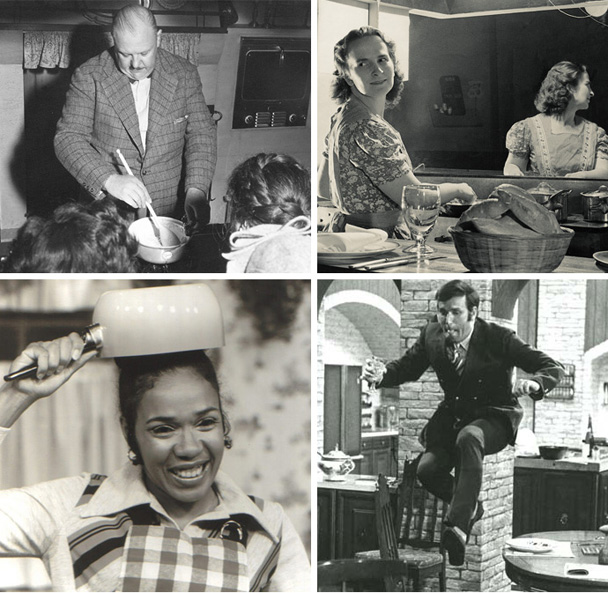You may be a cooking-show aficionado—or addict—but how thorough is your teleculinary literacy? If you believe Julia Child to be the first TV cooking-show host, astute though you would be to recognize her iconic status, you might benefit from a makeup class in TV history. In fact, Child was not even the first to shepherd French cooking to the airwaves. While TV trendsetters are certainly in our midst in great numbers today, there are some forgotten or surprising precursors to the modern-day cooking-show conventions we take for granted. Read on to discover some of the other firsts you might attribute to the wrong host.
1. James Beard: Whether you know it or not, you’re already familiar with the first nationally televised cooking-show host, the Dean of American Cookery himself. His vehicle, Elsie Presents James Beard in “I Love to Eat,” was not seen by many—who, after all, had a TV set in 1946, other than bars filled with men and fewer than 10 percent of American homes? Thus his gourmandise was decades too early for a like-minded audience. Nowadays we don’t even flinch at—in fact, we tune in for—Guy Fieri’s chowhound gusto.
2. Joseph Milani and Ernie Kovacs: The Cooking Channel boasts some comedy chops with hosts like Mo Rocca, James Cunningham, and Bitchin’ Kitchen’s Nadia G. Before these upstarts came along, Alton Brown used humor and wacky characters to teach kitchen science on the Food Network’s Good Eats. Three decades before Alton, even Galloping Gourmet Graham Kerr, who donned swim flippers and boxers to amuse his audiences, was not the first to intentionally mix humor with recipe instruction. Go back to—where else?—TV’s golden age for the mavericks. In 1949 chef Joseph Milani hosted a show in Los Angeles, titled simply Chef Milani, featuring characters, recipes, and slapstick that included airborne cans of Hunt’s peas and overwrought Italian accents. A year later, comedic master Ernie Kovacs made guest chefs his straight men on the Philadelphia program Deadline for Dinner. Kovacs also performed what was likely the first cooking-show spoof with Hungarian chef Miklös Molnar on Kovacs on the Corner in the early 1950s.
3. Dione Lucas: James Beard may have ventured into French cuisine on his short-lived show. But Dione Lucas was, according to Julia Child, “the mother of French Cooking in America.” From the late 1940s through the 1950s, The Dione Lucas Show, hosted by the European-born and -raised, Cordon Bleu–trained cook, brought sole Marguery and omelettes aux fines herbes to American audiences before they’d ever even heard of Julia Child. Lucas was also prescient (and fairly out of step with her canned food–touting contemporaries) in her urging viewers to embrace cooking as a form of artistic self-expression.
4. Joyce Chen: Many of my peers remember watching Yan Can Cook in the late 1970s and 80s, and though televised Chinese cooking was relatively unusual at the time, Martin Yan’s was not the first Asian countenance on cooking TV. In 1966 Cambridge, Massachusetts, restaurateur Joyce Chen hosted Joyce Chen Cooks on public broadcasting, demonstrating Peking duck and ravioli in the same studio used by Julia Child for The French Chef— all in the high heels she wore so she could use the extra-high counters constructed for Julia.
5. Graham Kerr: One of the galvanizing images of the earlier days of the Food Network was that of Emeril appearing on set in front of a live, cheering crowd, lending him in no uncertain terms the status of entertainer. The in-studio audience and high-energy host were novelties for the Food Network, but nearly three decades earlier, Galloping Gourmet Graham Kerr arrived on his stage by jumping over a chair while holding a glass of wine— rousingly greeted by a live studio audience.
6. Bob Lape: In 1970, New York’s ABC Eyewitness News sent an initially reluctant news reporter out to cover urbane restaurants and their innovative chefs. Twelve years later, Lape was widely recognized as the Eyewitness Gourmet and receiving sometimes close to 2 million requests for recipes highlighted on the segment. Not only did the feature predate the early Food Network program Food News & Views, hosted by Donna Hanover and David Rosengarten, but restaurateur Drew Nieporent once told Lape that the feature was the harbinger of the Television Food Network (the original name of the channel now known simply as the Food Network).
7. LaDeva Davis: Dial back a few recessions to 1975, and you will see LaDeva Davis on your non-flat TV screen, exhorting viewers to “eat well, save money” on public broadcasting’s What’s Cooking?. Rachael Ray and Sandra Lee are bursting with price-chopping hints today, but Davis predated these next-door-neighbor, everyday cooking vibes when she assured us that quiche Lorraine was really just “egg pie.” Her “BLT” episode even featured brains, liver, and tongue, calling for the creative use of organ meats long before offal was found on hip, pricey menus.
8. Jeff Smith: Though his legacy is marred by a disturbing scandal, the Frugal Gourmet’s cooking philosophy was, in the 1980s, a good decade ahead of his time. He virtually traveled to out-of-the-ordinary locations like Kenya and India because food for him was intertwined with cultural learning and self-understanding. As he said in one episode, “The Frugal Gourmet is committed to trying to understand other peoples and trying to educate your own children to understand other people. A cuisine, a style of cooking, is a way of thinking more than it is a way of eating. … We do things [with certain food products] because of the way we think about ourselves.”



 Pinterest
Pinterest


